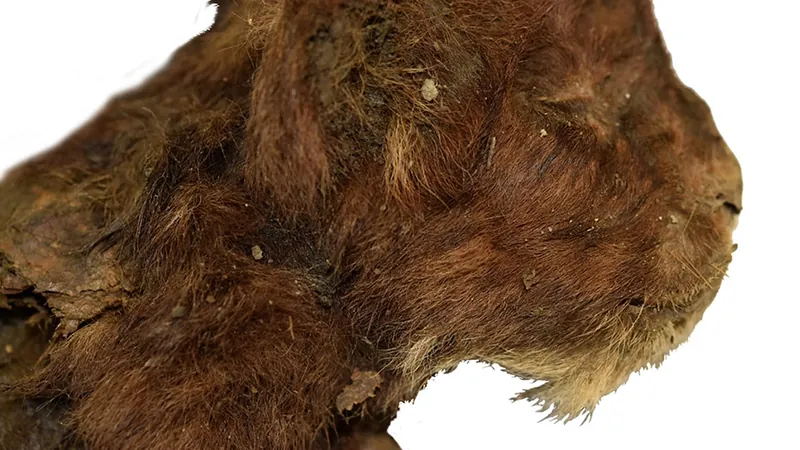
Unveiling the Past: The First Saber-Toothed Cat Mummy Unearthed in Siberia!
2024-11-19
Author: Ken Lee
For almost 200 years, the mystery of the saber-toothed cat's appearance has intrigued paleontologists, despite the numerous depictions in museums and popular culture, including the beloved Ice Age films. The secrets of these ancient, long-fanged predators have remained largely obscured, relying on incomplete fossil records and isolated footprints for clues. However, a remarkable discovery in the Siberian permafrost has offered a rare glimpse into the life of a saber-toothed cat that roamed the Earth around 32,000 years ago.
Paleontologists are buzzing with excitement over this groundbreaking discovery. "I was over-the-moon excited to see such an incredible specimen," said Ashley Reynolds from the Canadian Museum of Nature, who did not participate in the research but expressed her awe. The rarity of finding apex predators like saber-toothed cats is significant, as herbivorous species typically outnumber their carnivorous counterparts in the wild.
The mummy was discovered in 2020 by diggers searching for mammoth tusks, as confirmed by paleontologist A.V. Lopatin from the Russian Academy of Sciences. To the team's astonishment, the frozen remains presented a unique opportunity for study, culminating in a detailed report published in Scientific Reports on November 14.
This exquisite specimen, identified as a juvenile Homotherium latidens, also known as the scimitar-toothed cat due to its distinctive, serrated canine teeth, offers unprecedented insight into a life stage that paleontologists have known little about. Most saber-tooth fossils discovered to date belong to adult specimens, making this juvenile a valuable find.
The Unique Features of the Saber-Toothed Cat
The analysis led by Lopatin’s team revealed fascinating anatomical details about the cub. Homotherium latidens was a lanky and agile predator, adept at pursuing prey rather than relying on ambush tactics like its more famous counterpart, Smilodon. Its diet likely included juvenile mammoths and other large-sized animals in the tundra ecosystem.
Debate has long surrounded the appearance of saber-toothed cats, especially regarding their unique canines. While common depictions show these teeth protruding beneath the muzzle, a recent study indicated that Homotherium may have had longer, concealing lips that hid the canines when the mouth was closed. The mummy enhances this discussion, with the cub's lip being notably deeper than that of a modern lion cub, suggesting it may have shared similar features when fully grown.
An astonishing revelation from this find concerns the cub's coat color. Researchers anticipated a coloration aligned with its environment—the cold, grassy expanses of the mammoth steppe—but the cub's fur was uniformly dark brown, which was completely unexpected. This darker coloration mirrors findings from other Ice Age species, hinting that young saber-tooth cats were possibly born with different fur than their adult forms.
Understanding the Impact of Climate Change and Human Activity
As scientists continue to investigate this extraordinary mummy, the broader implications of saber-toothed cats' existence emerge. These apex predators thrived in ecosystems dominated by large prey like mammoths but ultimately faced extinction around 10,000 years ago, likely due to the combined effects of climate change and human expansion. With modern cats employing vastly different hunting strategies, the existence of Homotherium remains a subject of intense fascination for researchers, who will glean further insights from its soft tissue that has eluded them from skeletal remains alone.
This remarkable find not only enriches our understanding of saber-toothed cats but also captivates the imagination about the ancient ecosystems they inhabited. So, stay tuned! The saga of saber-toothed cats continues to unfold, and who knows what other shocking discoveries await in the frozen landscapes of Siberia?


 Brasil (PT)
Brasil (PT)
 Canada (EN)
Canada (EN)
 Chile (ES)
Chile (ES)
 España (ES)
España (ES)
 France (FR)
France (FR)
 Hong Kong (EN)
Hong Kong (EN)
 Italia (IT)
Italia (IT)
 日本 (JA)
日本 (JA)
 Magyarország (HU)
Magyarország (HU)
 Norge (NO)
Norge (NO)
 Polska (PL)
Polska (PL)
 Schweiz (DE)
Schweiz (DE)
 Singapore (EN)
Singapore (EN)
 Sverige (SV)
Sverige (SV)
 Suomi (FI)
Suomi (FI)
 Türkiye (TR)
Türkiye (TR)